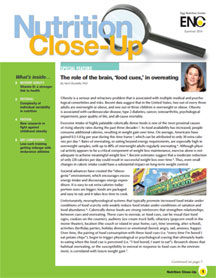
Nutrition Close-Up, Summer 2014 (pdf, 1.5 MB)
Articles in this Issue
The role of the brain, food cues, in overeating
By Kerri Boutelle, PhD
Obesity is a serious and refractory problem that is associated with multiple medical and psychological comorbities and risks. Recent data suggest that in the United States, two out of every three adults are overweight or obese, and one out of three children is overweight or obese. Obesity is associated with cardiovascular disease, type 2 diabetes, cancer, osteoarthritis, psychological impairment, poor quality of life, and all-cause mortality.
Read More >>
Vitamin D: a stronger link to health
By Taylor C. Wallace, PhD, CFS, FACN
Getting adequate vitamin D and calcium is essential for children, who need to grow strong bones, and for adults, who need to maintain strong bones and prevent bone loss. New findings
from the Womens Health Initiative, the largest clinical trial of >36,000 postmenopausal women, confirm the safety and synergistic benefits of these two nutrients, showing a 35-38 % reduction
in hip fracture incidence 1. If you dont get enough vitamin D, you are less likely to efficiently absorb calcium in the gut and may lose bone as you age. The development of low bone density
and/or osteoporosis later in life, which affects approximately 54 million Americans over the age of 50 years 2, is highly linked to suboptimal nutrition and physical activity patterns during young adulthood. After the age of 20-25 years, when bone growth reaches its full genetic potential, bone withdrawals can begin to exceed deposits (except in the skull, which increases in mass throughout the lifespan).
Read More >>
Complexity of individual variability in nutrition
By Tia M. Rains, PhD
One size does not fit all when it comes to health. Be it diet, exercise, or prescription medications, what works wonderfully for one person may produce little effect or even the opposite
effect in others. This is not surprising given metabolic differences between individuals. I remember observing this first-hand as an undergraduate student in a clinical chemistry course. Each
student underwent some basic blood tests and we compared results across the class. For some tests (e.g., liver enzymes), there was little variability among the students. But in others, there was quite a bit of diversity in results. For example, the blood glucose and insulin responses to an oral glucose tolerance test varied dramatically student to student.
Read More >>
New research in fight against childhood obesity
By Jamie I. Baum, PhD
The prevalence of obesity in the United States has more than doubled in adults and more than tripled in children and adolescents since the 1970s. Roughly one in three children ages 2-19 years is overweight or obese. Obese individuals have an increased risk of developing type 2 diabetes mellitus (T2DM), hypertension, and dyslipidemia. Once restricted to adults, these metabolic diseases are now being diagnosed in children. Increasing protein in the diet has been linked to improvements in glucose and insulin control, blood cholesterol, body composition, energy metabolism, as well as increased weight loss in adults. However, very little research has been focused on determining if increasing protein in the diet of school-aged children has comparable health benefits.
Read More >>
Low-carb training getting mileage with endurance athletes
By Dave Ellis, RD, CSCS
Training low has nothing to do with altitude and everything to do with intentionally training with low glycogen stores to enhance fat metabolism. It is the latest craze for endurance athletes who seek to preserve glycogen stores by optimizing utilization of fat stores through an adaptive process during their training. This is typically accomplished by lowering carb feed rates to <3 g / kg / d for five days or more 1. Fat intake is increased to compensate for lower carb calories with the idea that intramuscular triglyceride stores go up along with enzymes necessary for fat oxidation.
Read More >>
